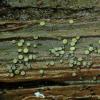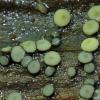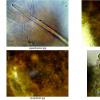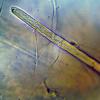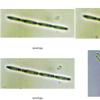
26-05-2017 23:02
 Bernard CLESSE
Bernard CLESSE
Sur branche pourrie et imbibée de feuillu, trempa

25-05-2017 23:38
Elisabeth StöckliBonsoir,Trouvé sur feuilles mortes de Filipendula

24-05-2017 14:28
Valencia Lopez Francisco JavierHola a todosEsta Scutellinia esta recolectada en l

23-05-2017 21:06
 Viktorie Halasu
Viktorie Halasu
Hello forum,Boudier dedicated his Galactinia miche

24-05-2017 17:21
Kenneth Preston-MafhamI have found this several times on O. crocata st

24-05-2017 16:13
Kenneth Preston-MafhamI have found this several times on O. crocata st

23-05-2017 22:31
Steve ClementsBonjour,Nous avons trouvé ce petit pyrenomycète
Vibrissea flavovirens (?) sur branche pourrie et imbibée de feuillu
Bernard CLESSE,
26-05-2017 23:02
 Sur branche pourrie et imbibée de feuillu, trempant dans le lit d'un ruisseau.
Sur branche pourrie et imbibée de feuillu, trempant dans le lit d'un ruisseau.Je n'ai pas fait la micro car je suis (quasi) certain de l'identification vu l'écologie, la phénologie et cette macro.
Qu'en pensez-vous?
Bernard
Hans-Otto Baral,
27-05-2017 07:39

Re : Vibrissea flavovirens (?) sur branche pourrie et imbibée de feuillu
Well it may be to recognise the species with certainty by the black exterior and short stipe, but the stipe I do not see on the pics, did you look for it?
I would always have a look with the mic.
I would always have a look with the mic.
Peter Püwert,
27-05-2017 09:10
Re : Vibrissea flavovirens (?) sur branche pourrie et imbibée de feuillu
Bernard CLESSE,
27-05-2017 10:10
Hans-Otto Baral,
27-05-2017 10:28

Re : Vibrissea flavovirens (?) sur branche pourrie et imbibée de feuillu
yes that speaks for flavovirens but better is to look for free spores and to check that they are 16-celled and disarticulate in 4 4-celled parts.
Bernard CLESSE,
27-05-2017 10:52
Hans-Otto Baral,
27-05-2017 11:14

Re : Vibrissea flavovirens (?) sur branche pourrie et imbibée de feuillu
fine!
Bernard CLESSE,
27-05-2017 11:22

Re : Vibrissea flavovirens (?) sur branche pourrie et imbibée de feuillu
Thank you for your pedagogy, Zotto !
Bernard
Bernard


